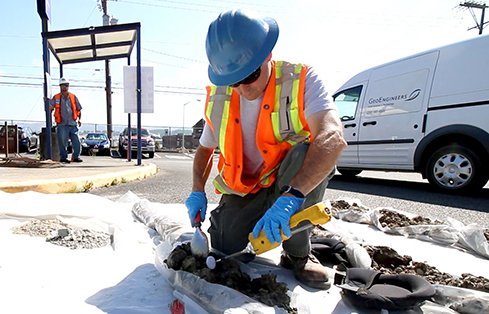 Our environmental professionals have experience drilling and testing in near-shore and marine environments.
Our environmental professionals have experience drilling and testing in near-shore and marine environments. GeoEngineers characterizes contamination and designs remediation plans for recent release events and historical brownfields.
GeoEngineers characterizes contamination and designs remediation plans for recent release events and historical brownfields. 6PPD-q in stormwater runoff is toxic to coho salmon.
6PPD-q in stormwater runoff is toxic to coho salmon. Careful environmental sampling and characterization is the foundation of all our natural resources work.
Careful environmental sampling and characterization is the foundation of all our natural resources work.
Emerging Environmental Contaminants
We work to investigate and remediate emerging chemical pollutants like PFAS and 6PPD in water and soil.
New contaminants of concern are identified as regulatory agencies like the Environmental Protection Agency (EPA) learn more about how synthetic chemicals affect the environment. Remediation strategies and regulations around these emerging environmental contaminants are often rapidly evolving, and GeoEngineers’ environmental scientists and engineers work hard to stay on the cutting edge.
What Are PFAS?
Per- and polyfluoroalkyl substances, or PFAS, are a class of synthetic fluorine compounds known for their ability to repel water and oil. PFAS are used in a variety of consumer products and in firefighting foams. Common PFAS include perfluorooctane sulfonic acid (PFOS), perfluorooctanoic acid (PFOA), and perfluorobutane sulfonic acid (PFBS).
PFAS Effects in Water and Soil
PFAS are persistent, bioaccumulative and toxic (PBT). Popularly known as “forever chemicals,” PFAS compounds can take decades or more to break down. They are highly soluble and often less likely to bind to soils, allowing them to migrate through groundwater into rivers and lakes. They accumulate in surface water, sediments, and fish tissue, and are very difficult to remove. The EPA is actively promoting research into the effects of PFAS and the best ways to remediate these challenging contaminants when they are discovered in municipal water supplies.
What is 6PPD/6PPD-q?
The chemical 6PPD (N-(1,3-dimethylbutyl)-N’-phenyl-p-phenylenediamine) and its byproduct 6PPD-quinone (6PPD-q) are common antioxidants used in rubber tire manufacturing, and urban stormwater regularly transports these compounds from roads into local watersheds. Environmental scientists are working to understand and mitigate a newly discovered environmental threat from these compounds, and GeoEngineers is helping to lead the way.
6PPD-q in Stormwater Linked to Salmon Deaths
Fish biologists have seen correlations between urban stormwater events and coho salmon deaths for years, but the precise cause was unknown. In 2020, researchers identified the likely culprit—6PPD and its byproduct 6PPD-quinone. Like all emerging contaminants, there is still a lot to learn about how these chemicals interact with specific environments, and their lethal effects. As a first step toward understanding and eventual mitigation, the Washington State Department of Ecology commissioned a detailed report on Best Management Practices (BPDs) for 6PPD/6PPD-q in stormwater. GeoEngineers’ environmental scientists Sue Bator and Alicia Candelaria were key contributors to the report.
Our Environmental Services for Emerging Contaminants Include
- Remedial Investigations/Feasibility Studies
- Cleanup Action Plans
- Regulatory Guidance
- Groundwater modeling
- Soil and Groundwater Remedial Design
- Long-term monitoring
- Natural Resource Damage Assessments
- Risk Assessments
- Expert Witnesses and Legal Support
- Source Control
- Brownfields Redevelopment
- Construction Observation
